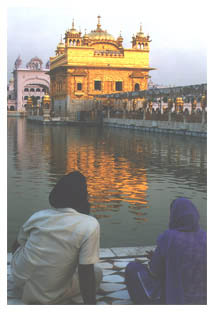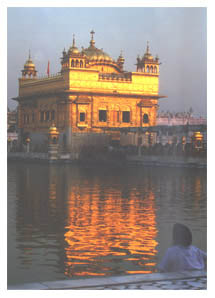|
'Sikh'ing the Golden Temple - Amritsar, India
Greetings once again!
When we last left off we were dismal in Delhi and
heading off for Amritsar in the Punjab to visit the
Golden Temple, the holiest site of the Sikh faith.
Sikhs, if you aren't familiar, think the character in the
movie, The English Patient or maybe you remember the
kid in Johnny Quest, the one with the turban. Well, the Sikh faith is a combination of Islam and Hinduism
and characterized by its long distinguished military
history. Actually, since they are a minority in
India,
they have lost most of the battles they have ever
fought to overwhelming forces, producing numerous
martyrs. The city of Amritsar is located in the far
northwestern Indian province of the Punjab, and is
only
15 miles from the Pakistani border.
The Golden Temple
is the center of the Sikh faith and a repository of
their holiest book. The Sikhs are most popularly
known for their turbans which all males wear from
their
youth. But lesser known is the fact that they all
carry daggers and the truly faithful wear special
short pants as symbolic of their preparedness for
battle at any time. In fact, even in this
'enlightened'
age, the Golden Temple itself was the site of recent
bloodshed in 1984 when extremist Sikhs holed
themselves
up in the Temple and the Indian army attacked and
destroyed much of the complex. It has since been
totally restored but the violent history lingers on.
This incident led directly to the assassination of
Indira Gandhi by her Sikh bodyguards for having
ordered
the very unpopular attack. All good Sikhs must make
the
pilgrimage there once in their lifetime and so we
went
to see what it was all about.
 What we found was truly unique and inviting. The
Sikhs
have a policy of unparalleled hospitality to any and
all pilgrims. They offer free food and lodging 24
hours
a day to those both in need and not, of course
donations are always welcome, but absolutely not
required. While we didn't take them up on the free
lodging, we did join them for a communal meal in
their
dining room. They open the doors every half hour and
those waiting outside filtered into a large room,
just quickly cleaned from the previous group. On the
floor are long canvas mats that run the length of the
room. We situated ourselves on the mats and within
five minutes the volunteers had thrown us a tin plate
and were beginning to ladle out scoops of dhal and
a handfuls of chapatis. To get more, one merely held
out their hand and more chapatis were placed in it.
We all sat together, the hungry, the needy, and the
merely curious to share in this wonderful
hospitality.
Outside the dining area, huge boiling vats of dhal
(lentil gravy) were being stirred with paddles and
volunteers were flipping chapatis with extraordinary
speed. And this ritual is done all day long! What we found was truly unique and inviting. The
Sikhs
have a policy of unparalleled hospitality to any and
all pilgrims. They offer free food and lodging 24
hours
a day to those both in need and not, of course
donations are always welcome, but absolutely not
required. While we didn't take them up on the free
lodging, we did join them for a communal meal in
their
dining room. They open the doors every half hour and
those waiting outside filtered into a large room,
just quickly cleaned from the previous group. On the
floor are long canvas mats that run the length of the
room. We situated ourselves on the mats and within
five minutes the volunteers had thrown us a tin plate
and were beginning to ladle out scoops of dhal and
a handfuls of chapatis. To get more, one merely held
out their hand and more chapatis were placed in it.
We all sat together, the hungry, the needy, and the
merely curious to share in this wonderful
hospitality.
Outside the dining area, huge boiling vats of dhal
(lentil gravy) were being stirred with paddles and
volunteers were flipping chapatis with extraordinary
speed. And this ritual is done all day long!
 The
gold facade shimmering in the late afternoon sunlight The
gold facade shimmering in the late afternoon sunlight
The Golden Temple itself is an incredible edifice in
the midst of an artificial lake, actually they call
it a tank. To enter the confines, everyone must
remove
their shoes and wear a head covering. Before every
entrance, a shallow pool of water runs across the
pathway which you step through as a symbolic
cleansing
of the feet, the lowliest part of the body. Inside
the
complex, pilgrims wander through the many marble pathways surrounding the tank and the floating
Temple.
Many pilgrims were lounging in the shade of holy
trees
or bathing in the holy waters of the tank. Everyone
was so friendly and on numerous occasions welcomed us
and explained that as honored guests, we were allowed
to partake in the rituals of the faith. It is
actually quite different from many other faiths which
bar non-believers from participating.
Case in point: Every morning and evening, they have
an elaborate ceremony in which they parade their holy
book to and from the temple where it resides during
the
day. Throughout the day, piped through many speakers,
singers within the Golden Temple sing aloud from the
holy book. That evening, we gathered in the top floor
of the Golden Temple and witnessed the beautiful
ceremony. First, after some final prayers, they
elaborately wrap the book in one hundred sheets,
taking
care to fold and crease the fabric just so. Then the
book is placed in a golden palaquin and carried on
the
shoulders of the faithful from the Temple to a
separate
building where it is housed in the evening. It was
quite an experience and we were carried along in the
enthusiasm and even carried the book on our shoulders
for one brief moment.
And lastly, we visited their shrine to the fallen martyrs
and learned about the five hundred new ways
to be killed, maimed and dismembered. It was actually
quite gruesome and Ann had to run out early before
she lost her free lunch. It was quite a change from Delhi and we immensely
enjoyed our time there. It feels different from much of India. As
a oasis in the desert, we found respite from the relentlessness that is
India. From the beggers and con artists at every corner, tugging your
sleeve. Amritsar, with its large population of Sikhs who tends to be
successful in business is richer than most places in India. Also, the
Sikh practice of offering food and shelter to the poor, keeps much of
the city much more well off than most. And at the center, a golden
shrine to call them home.
From there, we arranged a jeep to
Dharamsala in the mountains of Himachal Pradesh to
visit
the Tibetan Government in Exile which is the subject
of our next email.
For now, over and out
ann and doug
index | back
| next |
